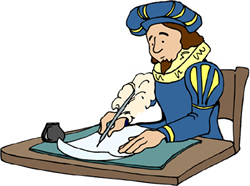Lesson 4.2B: Poetry Line Up
 Poetry comes in a variety of forms. Poetry comes in a variety of forms.
- Free Verse
- Blank Verse
- Sonnet
- Ballad
- Limerick
- Haiku
And those are just a few of the sketchy characters you might encounter in a poetry line up. The list goes on and on. For this reason, it is important to be able to recognize the different forms of poetry. If you can identify the form of a poem, you can understand the meaning of the poem more readily.
In this lesson, you will read and consider the poetry of a famous literary couple, Robert Browning and Elizabeth Barrett Browning. Your study of their poems will help you to understand the forms and types of poetry.
Poetic Forms
There are two main categories of poetry: narrative poetry and lyric poetry.
Narrative Poetry is poetry that tells a story. It combines poetic techniques, such as rhyme and alliteration, with the elements of fiction, such as character and plot with a beginning, middle, and end. Narrative poems can be very long, consisting of many pages.
Example: A ballad, such as "White Squall" by Stan Rogers, is a narrative poem.
Lyric Poetry may tell about events, but the focus is to create a mood or recall an emotion. Lyric poetry is frequently short and very personal poetry.
Example: A sonnet, a 14 line structured poem, is a lyric poem.
Sometimes it will be difficult to tell if a poem is a lyric or a narrative. But if you look very closely and cannot find a beginning, a middle, and an end as in a typical story, then it is not a narrative poem. Nearly all the poems in Sightlines 10 are lyric poems.
Both narrative and lyric poetry is organized into sections called stanzas. Stanzas are seperated by a single blank line. In many traditional forms of poetry, stanzas often have the same number of lines in them.
Traditional poetry also often relies on more formal elements like rhyme, whereas contemporary poetry is usually free verse, with no rhyme scheme.
| Note to student: If you are interested in learning more about sonnets and their structure, particularly the Shakespearean or Elizabethan sonnet, go to Will's World and click on Sonnet Solver. |
Mrs. Browning’s Lyric
The relationship of Elizabeth Barrett Browning and her husband, Robert Browning, whose poem, "Meeting at Night," you just read, resulted in some of the best love poems of the English language. Until their marriage, Elizabeth had been of frail health and under the roof of her very controlling father. When the couple met, Elizabeth was 40 years old, and had already published three collections of poems and was quite famous. The couple married on September 12, 1846, despite her father's objection to the union. The couple fled to Italy, and several years after their marriage Elizabeth presented to Robert a collection of forty-four love sonnets. In 1850, the collection was published with the title, Sonnets from the Portuguese (Robert Browning's affectionate pet name for his wife was "Portuguese").
The sonnet is a type of formal lyric poetry that was developed in the early fourteenth century. The sonnet form, with some variations, became very popular in England in the sixteenth century. It fell out of fashion thereafter, but modern writers seem to find sonnets interesting again.
There are many types of sonnets, but they share in common the following:
- The poem must have 14 lines.
- The poem has a distinct rhyme scheme.
- The poem is usually written in iambic pentameter.
- Usually an idea or problem is introduced and eventually a solution or answer to that problem is provided.
- Sonnets usually do not have a title, and are instead referred to by their first line or by number.
- Many sonnets are love poems. The power and the pleasure of nature are also common subjects of sonnets.
 Take a moment now and listen to Sonnet 43. Again, listen to the poem three times. The first time, simply try to follow along and get a general idea of the poem. As you listen to it again, see if you can identify the problem that is identified and then solved. Finally, listen for the rhyme and rhythm that words of the poem create. Take a moment now and listen to Sonnet 43. Again, listen to the poem three times. The first time, simply try to follow along and get a general idea of the poem. As you listen to it again, see if you can identify the problem that is identified and then solved. Finally, listen for the rhyme and rhythm that words of the poem create.
Summary
Completing this lesson has helped you to:
- recognize the many types and forms of poetry
- recognize a sonnet
|

